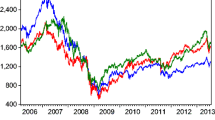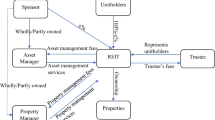Abstract
Real estate investment trusts have had a difficult time penetrating the European real estate market while non-real estate investment trusts were a widely accepted investment vehicle in all EU member states. This study aims to examine the lack of popularity of real estate investment trust in the European market through the lens of European property research association index performance, comparing real estate investment trust with non-investment trusts head to head in terms of return, co-movement, liquidity and volatility modelling using the GJR-GARCH model. The results showed that, that European real estate investment trusts indexes were not a good diversification strategy. They exhibited high volatility, did not return to the previous stock index level, gave a poorer return to their competitive counterpart, had a higher shock persistency and strong correlation with the stock market index. Although some advantages of real estate investment trusts were identified, such as higher liquidity and stronger resilience to bad news asymmetry, overall, the European real estate market was very fragile. Possible study nuances could be attributed to the fact that investment trusts in the European market were still very young, and their index initial starting point came right at the peak of the real estate price bubble.
Access this chapter
Tax calculation will be finalised at checkout
Purchases are for personal use only
Similar content being viewed by others
References
Agarwal, S., & Hu, M. R. (2014). Liquidity dynamics between REIT and property markets Presented at 27th Australasian Finance and Banking Conference. https://doi.org/10.2139/ssrn.2391025.
Allen, D. E., & Rachim, V. S. (1996). Dividend policy and stock price volatility: Australian evidence. Journal of Applied Economics, 6, 175–188.
Ambrose, B., Highfield, M., & Linneman, P. (2005). Real estate and economies of scale: The case of REITs. Real Estate Economics, 33(2), 323–350.
Anderson, I., Springer, W., Webb, J., & Fok, R. (2002). Technical efficiency and economies of scale: A non-parametric analysis of REIT operating efficiency. European Journal of Operational Research, 139(3), 598–612.
Baskin, J. (1989). Dividend policy and the volatility of common stock. Journal of Portfolio Management, 15, 19–25.
Bers, M., & Springer, M. (1997). Economies-of-scale for real estate investment trusts. Journal of Real Estate Research, 14(3), 275–291.
Bhargava, V., Dania, A., & Anderson, I. R. (2010). The impact of real estate operating companies and global REITs on performance and volatility of U.S. REITs. Journal of Real Estate Portfolio Management, 16(3), 279–288.
Black, F. (1976). Studies of stock price volatility changes. Proceedings of the 1976 Meetings of the American Statistical Association, Business and Economical Statistics Section, pp. 177–181.
Case, B., Yang, Y., & Yildirim, Y. (2012). Dynamic correlations among asset classes: REIT and stock returns. The Journal of Real Estate Finance and Economics, 44(3), 298–318.
Cheung, Y., & Lilian, K. (1992). Stock price dynamics and firm size: An empirical investigation. The Journal of Finance, 11(5), 1985–1997.
Christie, A. (1982). The stochastic behavior of common stock variances: Value, leverage and interest rate effects. Journal of Financial Economics, 10, 407–432.
Engle, F. R. (1982). Autoregressive conditional heteroscedasticity with estimates of the variance of United Kingdom inflation. Econometrica, 50(4), 987–1008.
EPRA. (2018). Global REIT survey. European Public Real Estate Association – EPRA.
Falkenbach, J., & Niskanen, H. (2012). European listed real estate: The capital structure perspective. Nordic Journal of Surveying and Real Estate Research, 9(1), 76–97.
FTSE Russell. (2019). FTSE EPRA Nareit developed REITs and Non-REITs indices. Retrieved October 31, 2019, from https://research.ftserussell.com/Analytics/Factsheets/Home/DownloadSingleIssue?issueName=ERGLANDENRG&IsManual=false.
Glosten, R. L., Jagannathan, R., & Runkle, D. E. (1993). On the relation between the expected value and the volatility of the nominal excess return on stocks. The Journal of Finance, 18(5), 1779–1801.
Grybauskas, A., & Pilinkienė, V. (2019). A comparative analysis of R.E.I.T.s, R.E.O.C.s and P.R.E.O.C.s using a stochastic frontier approach. Economic Research – Ekonomska Istraživanja, 32(1), 1542–1560. https://doi.org/10.1080/1331677X.2019.1632728.
Hussainey, K., Mgbame, C. O., & Chijoke-Mgbame, A. M. (2011). Dividend policy and share price volatility: UK evidence. The Journal of Risk Finance, 12(1), 57–68.
Kawaguchi, Y., Schilling, J., & Sa-Aady, J. (2012). REIT stock price volatility during the financial crisis. European Financial Management, 17(1), 1–33.
Kola, K., & Kodongo, L. (2017). Macroeconomic risks and REITs returns: A comparative analysis. Research in International Business and Finance, 42, 1228–1243.
Koulakiotis, A., & Kiohos, A. (2015). Positive feedback trading and long-term volatility links: Evidence from real estate markets of USA, Be/Lux and Switzerland. Applied Economics Letters, 23(2), 97–100.
Lee, S., & Stevenson, S. (2004). The case for REITs in the mixed-asset portfolio in the short and long run. Journal of Real Estate Portfolio Management, 11(1), 55–80.
Lee, C. L., Stevenson, S., & Lee, M. (2012). Futures trading, spot price volatility and market efficiency: Evidence from European real estate securities futures. The Journal of Real Estate Finance and Economics, 48(2), 299–322.
Liow, H. K. (2013). Volatility interdependence in European real estate securities markets. Who is the most influential? Journal of European Real Estate, 6(2), 117–138.
Liow, K. H., & Schindler, F. (2014). An assessment of the relationship between public real estate and stock markets at the local, regional, and global levels. International Real Estate Review, 17(2), 157–202.
Mahmood, M., Kuhle, J., Al-Deehani, T. M., & Bhuyan, R. (2015). Portfolio diversification benefits using real estate investment trusts – An experiment with US common stocks, equity real estate investment trusts, and mortgage real estate investment trusts. International Journal of Economics and Financial, 5(4), 922–928.
Morri, G., & Cristanziani, F. (2009). What determines the capital structure of real estate companies? Journal of Property Investment & Finance, 27(4), 318–372.
Nelson, C. R., Kim, C. J., & Bae, J. (2006). Why are stock returns and volatility negatively correlated? Journal of Empirical Finance, 14(1), 41–58.
Tahir, H., Latipah, S., & Zahrudin, Z. (2012). Measuring efficiency of real estate investment trust using data envelopment analysis approach. Paper presented at The Fifth Foundation of Islamic Finance Conference, Kedah, July. Retrieved from www.researchgate.net/publication/259009941_Measuring_Efficiency_of_Real_Estate_Investment_Trust_Using_Data_Envelopment_Analysis_Approach.
Topuz, J. C., & Isik, I. (2017). Meet the ‘born efficient’ financial institutions: Evidence from the boom years of US REITs. The Quarterly Review of Economics and Finance, 66(C), 70–99.
Wang, S., & Figlewski, X. (2000). Is the “Leverage Effect” a leverage effect? SSRN Electronic Journal. Retrieved from https://papers.ssrn.com/sol3/papers.cfm?abstract_id=256109.
Zhou, J. (2011). Long memory in REIT volatility revisited: Genuine or spurious, and self-similar? Journal of Property Research, 28(3), 213–232.
Zhou, J. (2016). A high-frequency analysis of the interactions between REIT return and volatility. Economic Modelling, 56(1), 102–108.
Author information
Authors and Affiliations
Corresponding author
Editor information
Editors and Affiliations
Appendix: ARIMA and GARCH Model Results for REITs and Non-REITs
Appendix: ARIMA and GARCH Model Results for REITs and Non-REITs
ARIMA models | |||
|---|---|---|---|
Index | European REITs | European Non-REITs | European Non-REITs |
Obs | 3555 | 3555 | – |
Model | ARMA(4, 3) | ARMA(3, 2) | – |
Method | MLE | MLE | – |
AIC | 12269.964 | 11408.298 | – |
Parameter | Coefficients | Coefficients | Coefficients |
AR(1) | 1.4789*** (0.239) | −0.6484*** (0.017) | – |
AR(2) | −1.3529*** (0.335) | −0.9445*** (0.012) | – |
AR(3) | 0.5969* (0.211) | 0.0757*** (0.016) | – |
AR(4) | −0.0608* (0.021) | – | |
MA(1) | −1.4213*** (0.238) | 0.7234*** (0.002) | – |
MA(2) | 1.2654*** (0.319) | 0.9965*** (0.003) | – |
MA(3) | −0.5357* (0.191) | – | |
GJR–GARCH models | |||
Distribution | Standardized student’s t | Standardized student’s t | Standardized student’s t |
Method | MLE | MLE | MLE |
Model | GJR-GARCH (1,1,1) | GJR-GARCH (1,1,1) | GJR-GARCH (1,1,2) |
AIC | 10696.6 | 9769.04 | 9768.25 |
Parameter | Coefficients | Coefficients | Coefficients |
Omega | 0.0236*** (0.00603) | 0.0257*** (0.0063) | 0.0316*** (00071) |
Alpha | 0.0452*** (0.01) | 0.0257*** (0.0092) | 0.0314*** (0.01) |
Gamma | 0.1133*** (0.002) | 0.1438*** (0.023) | 0.1858*** (0.029) |
Beta(1) | 0.8864*** (0.016) | 0.8847*** (0.018) | 0.5152*** (0.124) |
Beta(2) | − | − | 0.3387*** (0.119) |
Rights and permissions
Copyright information
© 2021 The Author(s), under exclusive license to Springer Nature Switzerland AG
About this paper
Cite this paper
Grybauskas, A., Pilinkienė, V. (2021). The Volatility Case of European REITS and Non-REITs. In: Bilgin, M.H., Danis, H., Demir, E. (eds) Eurasian Business and Economics Perspectives. Eurasian Studies in Business and Economics, vol 18. Springer, Cham. https://doi.org/10.1007/978-3-030-71869-5_3
Download citation
DOI: https://doi.org/10.1007/978-3-030-71869-5_3
Published:
Publisher Name: Springer, Cham
Print ISBN: 978-3-030-71868-8
Online ISBN: 978-3-030-71869-5
eBook Packages: Business and ManagementBusiness and Management (R0)




